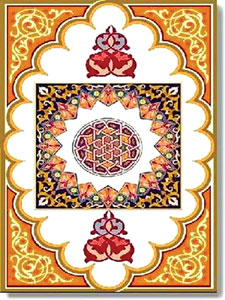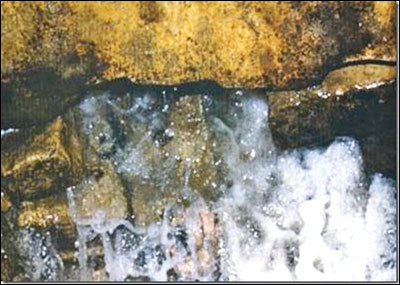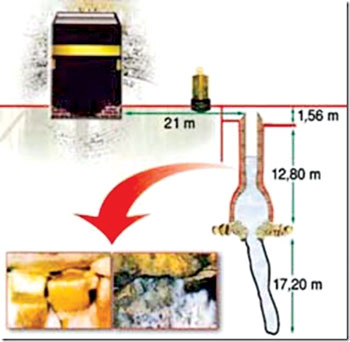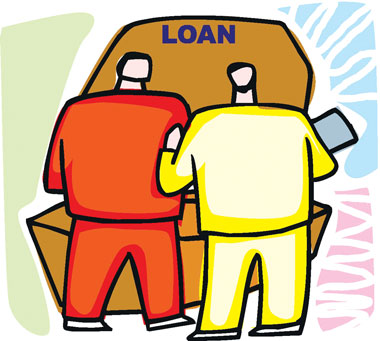|
ISLAM
Islam and renaissance
Mesbah Uddin
It is quite rare these days to hear anything good about Muslims from
the Anglo-American news media. There are, however, some exceptions and
Professor of History at Columbia University, New York Dr Richard Bulliet,
is one of them.
|

Arabic language |
According to Bulliet, Muslims were cultural torch-bearers during
Europe’s Dark Ages and helped to launch the Renaissance. The term
Renaissance literally means “rebirth,” and it meant the recovery of
European civilization after 800 years of intellectual and literary
stagnation.
Roman civilization began around 250 BC and had waned by 500 AD. But
the Renaissance emerged around 1,300 AD - a difference of 800 years.
Those eight centuries are referred to as the Period of Darkness by
contemporary historians. While little progress may have occurred in the
European West during those days, partly because of religious
dogmatism...did the rest of civilization also take a recess for 800
years?
The answer is “surely not.” During Europe’s Dark Ages, Islamic
civilization created an ideal environment for innovative science and
technology and ultimately helped to push back the cultural darkness in
Europe. As Professor Bulliet commented “if it had not been for the
Muslims, we might never have had a Renaissance at all.”
Islam emerged during the seventh century in the small Arab city of
Mecca. While it was not a new monotheistic faith, its message was filled
with fresh insight and novelty. In fact it had more commonality than
differences with other major faiths (such as Judaism and Christianity).
Islam did not promote an agenda to change Christianity or Judaism;
rather, its precepts were built on the foundations of Judeo-Christian
prophethood.
Islam taught an uncompromising goal of abolishing social injustice
and placing true righteousness above personal power and enrichment.
Within a short time, the message of Islam spread throughout the Arabian
Peninsula, Palestine, Jordan, Syria, Iraq, Persia, North Africa, Spain
and all the way to the Indian subcontinent. Even far-away China felt the
influential attraction of Islam.
Muslims originated from simple desert dwellers. But they had a
determined desire to increase their collective knowledge, technology and
means of life. These motivations resulted in wide-ranging travel; and
where Muslims went, they carried the message of Prophet Muhammad with
them. During those expanding days of Islam, the society of its believers
was free from religious constraint. Muslims represented a collective
influence that was honoured within many other civilized societies,
despite their differences of race, religion and areas of origin.
One of the greatest periods of Islamic achievement can be traced to
the time of Caliph Harun-ar-Rashid, whose diverse empire drew on the
talents of many people - the Hebrew physician, the Greek philosopher,
the Turkish soldier and many more.
Folk stories like Aladdin and the Magic Lamp, Sinbad the Sailor, Ali
Baba and the Forty Thieves were not based on Arabic lore alone, but
gradually took on an Arabic expression.
|

Ar-Razi |
During the heyday of Islamic civilization, people spoke not only the
official language of Arabic, but also Turkish, Hebrew, Persian, Greek
and other languages of origin.
An exclusive style of artistic design known to us as ‘Arabesque,’ is
based on the skilled and imagination graphic presentation of Arabic
letters. As well, thousands of scientific names in modern English have
Arabic roots.
In general if we notice the syllable al at the beginning of a word,
it most likely began in Arabic. For instance alcove is derived from al-qubbah,
almanac is from al-manaakh, algebra is from al-Jabr, alcohol from al-kuhul,
alkali from al-qili and so on.
The process of algorithms is named after al-Khwerazmi, a renowned
mathematician and notable advisor to Caliph Harun-ar-Rashid. And there
was also Al-Kimia, a chemist who gave his name to the practice of
alchemy. Muslim chemists worked very diligently to enhance and prolong
life and their efforts eventually paved the way for modern chemistry and
pharmacology.
Similarly, Muslim doctors contributed a great deal to improving
surgical techniques during the Middle Ages.
In this regard, Prof. Bulliet wrote, they also made great strides in
saving life and healing the sick. They invented many new medical
instruments and made important breakthroughs in optics and surgery.
Islamic medicines were much more advanced than anything going on in
Europe.
The research of a famous ninth-century Muslim physician called
Ar-Razi (known in the West as Razi) still occupies an influential place
in the field of medical treatment. Another leader in the healing arts
was Ibn Sina of Bukhara (known as Avicenna in Europe).
During the tenth century, he wrote a scientific encyclopedia entitled
the Canon of Medicine - it was unrivalled in medical history and
considered an essential European reference source throughout the
seventeenth century.
Muslim physicians also introduced the concepts of pharmaceuticals and
hospital care.
|

Abstract drawing |
From the seventh to the twelfth centuries, people from Islamic
countries excelled in literature, science, trade and commerce. Modern
science could not function without mathematics and mathematics is built
on a universal system of numbers and symbols.
In this context Professor Bulliet emphasized gratefully that, this is
where the medieval Muslims made a contribution that benefits each of us
every day. The Roman counting method that existed prior to the Islamic
decimal system was cumbersome and unwieldy even for experts of its day.
To eliminate the chronic counting hardship, Muslim mathematicians
imported a new system from India and improved it with the introduction
of ‘zero.’
The system comprised nine digits of graduated value, along with the
zero which has no intrinsic value, but can change the quantity of other
numbers infinitely.
When we place “0” after 1, for example, the value is ten - two zeros
produces 100, and so on. In modern science, this is known as the decimal
system. As Professor Bulliet noted it’s thanks to Muslims that we no
longer have to write MCMLXXXIV and instead we write 1984.
Although the decimal system was developed to its full potential by
Arab scientists Professor Bulliet acknowledged that strictly speaking,
they are Indian numerals but if it hadn’t been for mathematicians of the
Islamic Empire, they might never have reached the Western World.
Paper, though indispensable as a carrier of knowledge to the
civilized world, was not invented in Europe, but rather in China.
Throughout the world, however, the refinement of the paper-making
process bears the hallmark of Muslim artisans.
From the eighth to the eleventh centuries, paper-making technology
extended all the way from Samarkand to Spain – a prime example of how
Muslims not only developed original inventions but also reinvented those
of others, making them accessible throughout the known world.
Although Greek philosophy, literature and science is intricately tied
to the European Renaissance, Socrates, Plato, Aristotle, Euclid,
Hypocrites and other Greek notables were unknown during the preceding
800 years of intellectual darkness.
The powerful Roman Christian church condemned Greek as a ‘pagan’
language; as a result, numerous books were destroyed, leaving only
Arabic translations made by Muslim scholars. Without those Arabic
versions, much of classical learning would have been irretrievably lost
to the West.
Caliph Abdallah-al-Mamun (son of Harun ar-Rashid) was one of the most
zealous and influential patrons in supporting the translation of all the
known Greek literature into Arabic. In 830 AD, he established the House
of Wisdom, a centre dedicated to this project.
|

Algebra |
During the tenth and eleventh centuries, intellectually eager
Europeans flocked into Islamic university cities like Cordoba, Baghdad,
Damascus and Cairo, where most of the translations of classical texts
from Arabic into Latin took place. These cities were not just for the
Europeans to study Greek literature alone, for they also housed great
collections from the works of Chinese, Indian, Persian, Hebrew and other
scholars.
In those early days of higher learning, students used to sit around
the chairs of their teachers. The honoured position of the chair,
surrounded by students, eventually developed into the common
identification of academic faculties such as ‘Chair of Philosophy,’
;Chair of History,’ and so on.
Another scholarly tradition holds that the academic gowns worn during
convocation (and daily in some traditional schools) derive from normal
Islamic garb, such as would have been worn at Al-Azhar in Cairo - dating
from 970 AD, it is credited as the first and oldest university of the
world.
While Western society takes pride in its present-day scientific,
technological and cultural advancements, few realize the significance of
the intellectual stepping-stones provided by Muslim scholarship and
innovation, especially during periods of European oppression and
stagnation.
The Muslims of the Middle Ages and earlier were instrumental in
keeping the flame of civilization and advanced learning alight at times
when other societies were unable to do so. And because of that
intellectual perseverance, we all benefit.
(Mesbah Uddin
lives in Ottawa and has contributed to the Media Monitors Network since
2003. His articles have been widely published by print and online
magazines. This article was extensively edited and abridged for the
Canadian Islamic Congress Friday Magazine)
Zamzam water :
History and its significance
Allah made all living creatures out of water. People require water
for almost everything - agriculture, construction, transportation and
for cooling and heating. But not all water carries the same value and
significance as Zamzam water.
|

Zamzam water coming out from its main rock under the earth |
Muslims refer to the water of Zamzam, a small well located adjacent
to the Ka’bah in Masjid Al Haram in Makka, as something revered and
unique. They crave and love to drink it whenever they can. And those who
go on Hajj pilgrimage return home carrying Zamzam water for thousands of
miles as prized possession as special gift to friends and families.
One of the greatest attributes of Zamzam is that it never dries up.
Every year, millions of pilgrims drink Zamzam water. So, what is so
special about Zamzam water? In a word - everything.
There is nothing ordinary about it. From the miracle of how it came
to being in the middle of the desert, its consistency throughout
thousands of years to its beneficial qualities and the fact that it
never dries up this water is special.
This small well is far away from any other source or body of water.
Zamzam water has scientifically been proven to contain healing qualities
due to its higher content of Calcium and Magnesium Salts and also the
natural fluorides that encompass a germicidal action.
This well always fulfilled the demand for water and maintained the
same salt composition and taste ever since it came into existence. Its
portability has always been universally recognized as pilgrims from all
over the world visit Ka’bah every year for Hajj and Umrah, but have
never complained about it. Instead, they have always enjoyed the water
that refreshes them. Water tastes different at different places.
Zamzam water’s appeal has always been universal. This water has never
been chemically treated or chlorinated as is the case with water pumped
into the cities. Biological growth and vegetation usually takes place in
most wells. This makes the water unpalatable owing to the growth of
algae causing taste and odour problems. But in the case of the Zamzam
water well, there wasn’t any sign of biological growth.
History of Zamzam water
Prophet Ibrahim, patriarch of all three revealed religions - Islam,
Christianity and Judaism - was ordered by Allah to leave his chaste
wife, Hajira and his baby, Ismail in the desert of Arabia, with no
friend or helper, then the answer to the sustenance of life for this
‘forlorn’ mother and son was given within a few days.
The child was striking his heels upon the ground due to severe
thirst. The mother was also becoming restless due to the lack of water,
and she ran up one mountain and down again and ascended the other
mountain, in search of water, hoping to find something to sustain the
life of her child.
Angel Jibreel made an appearance. With a strike of his heels or an
indication of his hands or his wings - a spring started flowing. As soon
as the water was sighted, Hajira was overtaken with joy.
|

A drawing of how the water comes from the well |
Her sadness and despondency was immediately removed and replaced by
sheer joy. She quenched her own thirst and that of her child. She filled
a container with the water and built a sand wall around the spring in
order to dam it up.
The Prophet (PBUH) said that, had Haajira not done this, this water
would have become like a sea rather than a spring, and it would have
saturated the entire earth.
Two Egyptian engineers - Tariq Hussain and Moin Uddin Ahmed - who
conducted a special survey into the water had this to state:
“When we reached the well, it was hard for me to believe that a pool
of water, more like a small pond, about 18 by 14 feet, was the well that
supplied millions of gallons of water every year to Hajjis ever since it
came into existence. I started my investigations and took the dimensions
of the well. I asked the man to show me the depth of the well.
First he took a shower and descended into the water. Then he
straightened his body. I saw that the water level came up to just above
his shoulders. His height was around five feet, eight inches.
He then started moving from one corner to the other in the well
(standing all the while since he was not allowed to dip his head into
the water) in search of any inlet or pipeline inside the well to see
from where the water came in. However, the man reported that he could
not find any inlet or pipeline inside the well.
I thought of another idea. The water could be withdrawn rapidly with
the help of a big transfer pump which was installed at the well for the
Zamzam water storage tanks. In this way, the water level would drop
enabling us to locate the point of entry of the water. Surprisingly,
nothing was observed during the pumping period, but I knew that this was
the only method by which you could find the entrance of the water to the
well.
So I decided to repeat the process. But this time I instructed the
man to stand still at one place and carefully observe any unusual thing
happening inside the well. After a while, he suddenly raised his hands
and shouted, “Alhamdulillah! I have found it. The sand is dancing
beneath my feet as the water oozes out of the bed of the well.”
To be continued
Beautiful Loan - Qardh Hasan
|

Giving a loan is no harm |
In several verses, the Holy Qur’an extols the virtue of advancing
loans to the needy. The Holy Qur’an describes loans as Qardh Hasan -
beautiful loan. It is also very significant that Allah describes the
loan as Qardh given to Him personally. In this transaction Allah has
become the ‘Debtor’.
The virtues of beautiful loan even exceed the virtues and rewards of
charity. According to one Hadith, giving a loan is 16 times more
meritorious than even charity. This virtue is inscribed on one of the
portals of Jannat. Another narration mentions 33 times.
The creditor should therefore not vitiate and destroy his reward in
the hereafter with harshness, threats and abuse when the debtor is
genuinely unable to meet his commitment. The Holy Qur’an mentions three
stages of beautiful loan.
If the debtor is genuinely unable to pay, and is in difficult
financial straits, then the first and best option is to waive the entire
debt for the sake of Allah.
If the creditor’s financial position does not allow him to waive the
whole debt, or he lacks the spiritual stamina for digesting such immense
benefits, then the next and lower option is to waive part of the debt.
To be continued |



